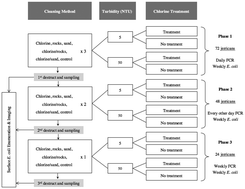Efficacy of locally-available cleaning methods and household chlorination at inhibiting biofilm development in jerricans used to store household drinking water
Abstract
Jerricans are commonly used to store household drinking water. However, biofilms can grow on jerrican surfaces and contaminate water. To investigate mechanisms to inhibit biofilm growth, 72 5 L jerricans containing E. coli-spiked water were incubated for 10 weeks in the laboratory. Jerricans were stratified by: water treatment with chlorine; turbidity; and, regular cleaning with NaOCl, rocks, sand, NaOCl/rocks, and NaOCl/sand. At study end, surface E. coli was enumerated and biofilms imaged using epifluorescence microscopy; free chlorine residual was tested regularly. We found biofilms grew rapidly in jerricans (presence confirmed in 3 weeks), and chlorine demand within jerricans increased over time as FCR decreased from 1.16 to 0.59 mg L−1 over the course of the study in 5 NTU treated waters. Biofilm growth was significantly inhibited by water treatment with chlorine (p = 0.03), and was inhibited by cleaning with NaOCl or NaOCl/rocks. Cleaning with rocks increased surface roughness, which promotes biofilm growth. These results highlight the need for research on locally-appropriate cleaning methods and/or alternatives (e.g. replacement, biofilm-resistant surfaces) to ensure jerricans provide safe storage of drinking water.



 Please wait while we load your content...
Please wait while we load your content...